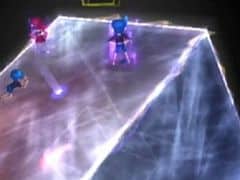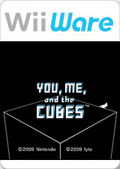You can trust VideoGamer. Our team of gaming experts spend hours testing and reviewing the latest games, to ensure you're reading the most comprehensive guide possible. Rest assured, all imagery and advice is unique and original. Check out how we test and review games here
Weird and complicated. That’s what you’ll probably think when you first play You, Me and the Cubes, the new WiiWare puzzle game from Japanese developer Kenji Eno (Altered Beast, D). But really it’s neither. It’s essentially a weight distribution conundrum that tests how quickly you’re able to balance floating cubes against the clock.
It works like this: a cube is magically suspended in the void. Two “Fallos”, the game’s faceless little people (basically weights), are generated by shaking the Wii Remote. Then, using the pointer, two landing spots are selected, one for each Fallo (you can only send Fallos onto cubes two at a time). Then, with a flick forward, the Fallos are sent flying through the air towards the cube, landing as instructed.
Ideally, you want to place them so that after they land the cube hardly tilts at all, or is balanced. Place them so the weight isn’t evenly distributed, however, and the cube will begin to tilt. Then gravity will take control, and the Fallos will begin to slide. If the cube tilts too much, they’ll eventually fall off, spiralling with a heart-wrenching scream into the nothingness that is the void.
To complete a stage, at least one Fallo must be stood on each cube and remain there for the duration of a “Judging Period” (about three seconds). Even if you fling the required number of Fallos onto a cube, you can’t move on unless you’ve got at least one Fallo on each cube. Once done, the camera rotates and a new cube appears. The process is then repeated.
Each stage plays out in the same way: you begin with one cube, then another is added, then another, up to a total of six. Once you’ve managed to balance the minimum number of Fallos within the time limit on all of the cubes, that’s a stage over. Then it’s on to the next. There are 36 stages, divided into six levels.
The game’s subtle nuances add a crucial layer of depth. Not only are you battling against the clock, you’re battling against yourself. When a Fallo falls into the abyss, five seconds are knocked off of your remaining time. There are also enemies to contend with. Sometimes when shaking the Wii Remote to create Fallos you’ll hear a different sound from the controller speaker. This means that you’ve created a “Pale Fallow”. These ghostly figures move around the cubes causing havoc, knocking Fallos off of their feet. But you can target them and send a regular Fallo to knock it out, adding ten seconds to your time limit as a reward.
You’re also able to “buff” your Fallos with particularly clever placement. Fallos that trigger a “Good Play” are buffed so that they’re extra stable for a short period and won’t succumb to gravity’s forces. Nail another Good Play and you’ll get the wonderfully-named “Very Good Play”, which further strengthens their resistance to the big G. When you’re contending with six cubes, nailing Good Plays and Very Good Plays can be the difference between success and failure.
The further into the six levels you get, the more complex the game becomes. Occasionally the cubes will have different properties, some helpful, some unhelpful. Freeze Cubes, for example, freeze the entire cube structure in place when a Fallo lands on them. Cap Cubes, however, limit the number of Fallos that can be on a cube face at once. Go over the limit and they’ll be chucked off. The stages in level six are particularly difficult, with brutally short time limits. Be prepared to fail over and over again before you even come close to completion.
You, Me and the Cubes’ genius is in its simplicity and how well executed it is. It’s a mechanic that works the way it should, like the best puzzle games. You grasp the rules in a flash, and from there the tight controls ensure frustration is the result of your own stupidity and nothing else. All that remains is you, your brain, and the puzzle before you. While the game is an all-round pleasant, even relaxing experience, it can get quite frantic at times, especially in the later levels when there are more Fallos on the multiple cubes than you can keep track of. When you hear the clock count down towards zero, frantic flinging is required to balance the cubes in time for a successful judgement.
The game is strengthened by the superb minimalist art style, the electro chill-out music, the creepy, almost ghostly sound effects and, most of all, the heart-warming camaraderie between the Fallos. Kenji Eno must be credited here with some inspired design decisions. The Fallos will help each other as the cubes tilt. If one begins to slide, the other will try and pull them to safety. Their faceless heads and pink and blue hair (Fallos are girls or boys) lend them a tragic look – they are at your mercy. When they fall into the abyss, it’s because you messed up. When they save themselves from certain doom, you can’t help but feel all warm inside.
You, Me and the Cubes’ co-operative two-player mode, while not a significantly different experience, is also worth checking out. Here, each player flings one Fallo. The game rewards perfectly timed “Synchro-Flings” with stability – your Fallos can’t fall off for a few moments. Because of this, you’ll find yourself counting down out loud so you and your partner can flick forward at exactly the same time. Pale Fallos don’t appear in two-player mode. Instead, whenever one of your Fallos falls into the abyss, a creepy Shade Fallo is generated – defeat it with a targeted Synchro-Fling.
You, Me and the Cubes’ failing, however, is that it is bare bones and lacks variety. For a 1000 Nintendo Point (£7) game, you expect a little more than 36 stages and a two-player mode. There is no online leaderboard, so there is no competitive motivation (aiming for the best possible scores on each stage will be a personal mission only). There are no unlockables, either. The levels are samey, too. Bar the introduction of different cube types, progressing through the single-player experience feels repetitive.
And while the game is a perfect fit on the Wii, and really the kind of quirky experience the WiiWare channel was designed for, the waggle controls are pointless. It doesn’t matter how fast you swing, or the direction, the Fallos will always fly towards the cube in the same way; using a thumb stick to control the on screen reticules would have worked just as well. And having to shake the Wii Remote to generate Fallos before you can fling them quickly gets old.
Still, You, Me and the Cubes is well worth a download if you’re after a well-executed, cleverly designed puzzle game. It won’t last you particularly long – while the latter stages are fiendishly difficult, the game isn’t infinitely replayable like Tetris, for example. And the novelty of the quirky core mechanic soon wears off. But while it lasts You, Me and the Cubes is a compelling weight and gravity conundrum, and a successful return to game development for Kenji Eno.

/https://oimg.videogamer.com/images/18d7/you_me_and_the_cubes_8.jpg)
/https://oimg.videogamer.com/images/4692/you_me_and_the_cubes_7.jpg)
/https://oimg.videogamer.com/images/4f38/you_me_and_the_cubes_6.jpg)






